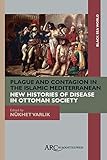Plague and Contagion in the Islamic Mediterranean / Nükhet Varlik.
Material type: TextSeries: Black Sea World Publisher: Leeds : ARC Humanities Press, [2017]Copyright date: ©2017Description: 1 online resource (335 p.)Content type:
TextSeries: Black Sea World Publisher: Leeds : ARC Humanities Press, [2017]Copyright date: ©2017Description: 1 online resource (335 p.)Content type: - 9781942401155
- 9781942401162
- 614.5/732
- online - DeGruyter
| Item type | Current library | Call number | URL | Status | Notes | Barcode | |
|---|---|---|---|---|---|---|---|
 eBook
eBook
|
Biblioteca "Angelicum" Pont. Univ. S.Tommaso d'Aquino Nuvola online | online - DeGruyter (Browse shelf(Opens below)) | Online access | Not for loan (Accesso limitato) | Accesso per gli utenti autorizzati / Access for authorized users | (dgr)9781942401162 |
Frontmatter -- CONTENTS -- LIST OF ILLUSTRATIONS -- INTRODUCTION -- PART ONE. RETHINKING HISTORIOGRAPHY AND SOURCES -- PART ONE RETHINKING HISTORIOGRAPHY AND SOURCES -- SCHOLARS, SUFIS, AND DISEASE: CAN MUSLIM RELIGIOUS WORKS OFFER US NOVEL INSIGHTS ON PLAGUES AND EPIDEMICS AMONG THE MEDIEVAL AND EARLY MODERN OTTOMANS? -- “ORIENTAL PLAGUE” OR EPIDEMIOLOGICAL ORIENTALISM? REVISITING THE PLAGUE EPISTEME OF THE EARLY MODERN MEDITERRANEAN -- PART TWO. DISEASES IN CONTEXT -- A MODEL DISASTER: FROM THE GREAT OTTOMAN PANZOOTIC TO THE CATTLE PLAGUES OF EARLY MODERN EUROPE -- VETERINARY MEDICINE IN NINETEENTH‑CENTURY EGYPT -- SMALLPOX IN THE HAREM: COMMUNICABLE DISEASES AND THE OTTOMAN FEAR OF DYNASTIC EXTINCTION DURING THE EARLY SULTANATE OF AHMED I (R. 1603–17) -- EPILEPSY AS A “CONTAGIOUS” DISEASE IN THE LATE MEDIEVAL AND EARLY MODERN OTTOMAN WORLD -- PART THREE. RESPONSES TO EPIDEMIC DISEASES -- RELIGION AND OTTOMAN SOCIETY’S RESPONSES TO EPIDEMICS IN THE SEVENTEENTH AND EIGHTEENTH CENTURIES -- PLAGUE IN EIGHTEENTH-CENTURY CAIRO: IN SEARCH OF BURIAL AND MEMORIAL SITES -- NOWHERE TO RUN TO, NOWHERE TO HIDE? SOCIETY, STATE, AND EPIDEMIC DISEASES IN THE EARLY NINETEENTH-CENTURY OTTOMAN BALKANS -- CHOLERA, PILGRIMAGE, AND INTERNATIONAL POLITICS OF SANITATION: THE QUARANTINE STATION ON THE ISLAND OF KAMARAN -- BIBLIOGRAPHY -- INDEX
restricted access online access with authorization star
http://purl.org/coar/access_right/c_16ec
Over the last decade or two, the field of Middle Eastern and Islamic studies has witnessed the convergence of new perspectives on the history of epidemic diseases. A growing body of scholarship enables us to explore connections between Middle Eastern studies and the histories of medicine and health. This study serves as testimony that the field has reached a certain level of maturity. Contributors to the volume tackle various questions of historiography and sources, test new interdisciplinary methodologies, and ask new questions while revisiting older ones. Essays in the volume discuss diseases that affected human and non-human populations in areas stretching from the Red Sea and Egypt to Anatolia, the Balkans, and the Black Sea, in the early modern and modern eras. The volume contributes to Ottoman studies, the history of medicine, Mediterranean and European history, as well as global studies on the role of epidemics in history.
This book discusses diseases that affected human and non-human populations in areas stretching from the Red Sea and Egypt to Anatolia, the Balkans, and the Black Sea, in the early modern and modern eras. It tackles various questions of historiography and sources, tests new interdisciplinary methodologies, and asks new questions while revisiting older ones. It contributes to Ottoman studies, the history of medicine, Mediterranean and European history, as well as global studies on the role of epidemics in history.
Mode of access: Internet via World Wide Web.
In English.
Description based on online resource; title from PDF title page (publisher's Web site, viewed 27. Jan 2023)


